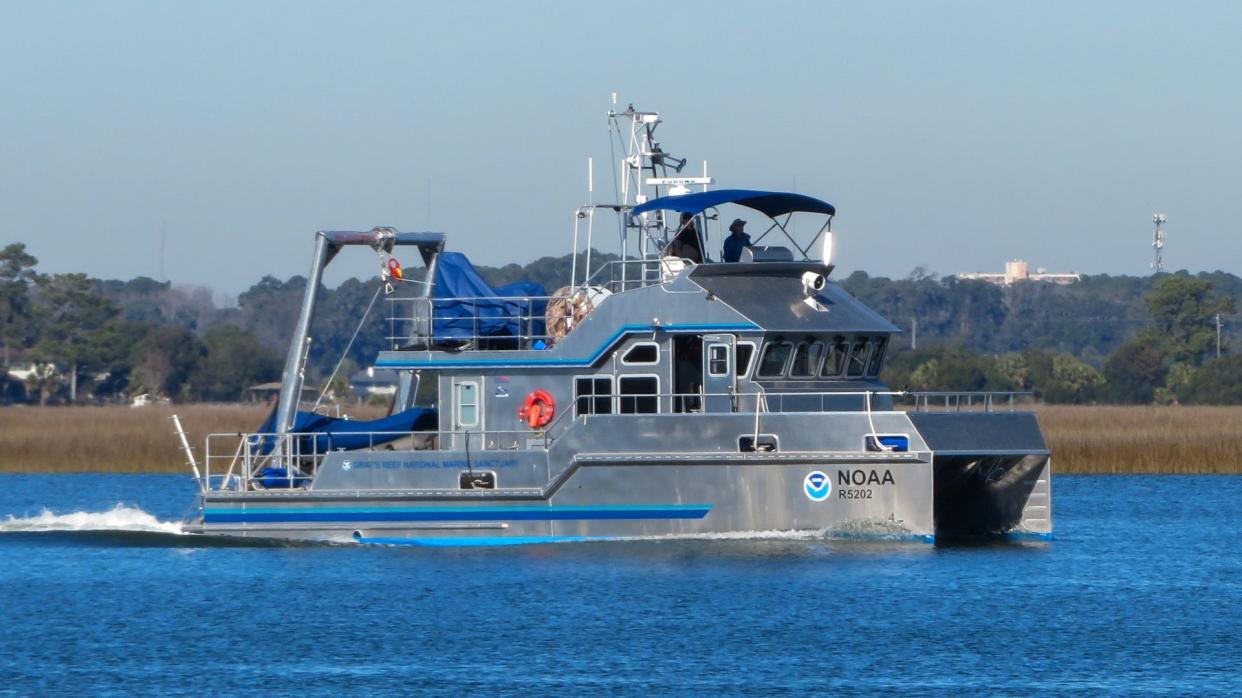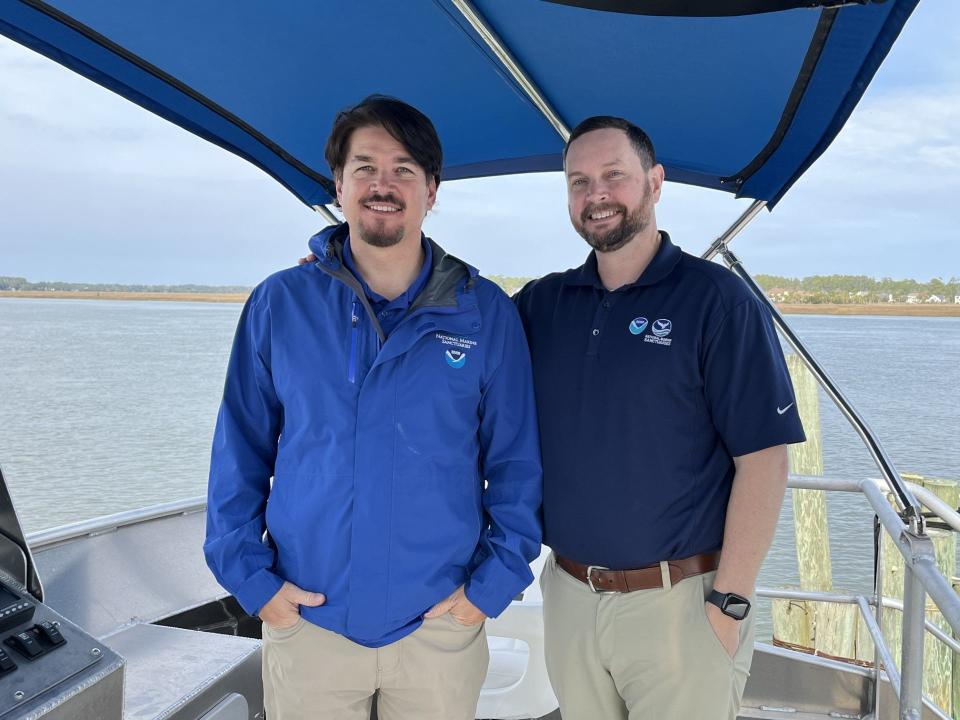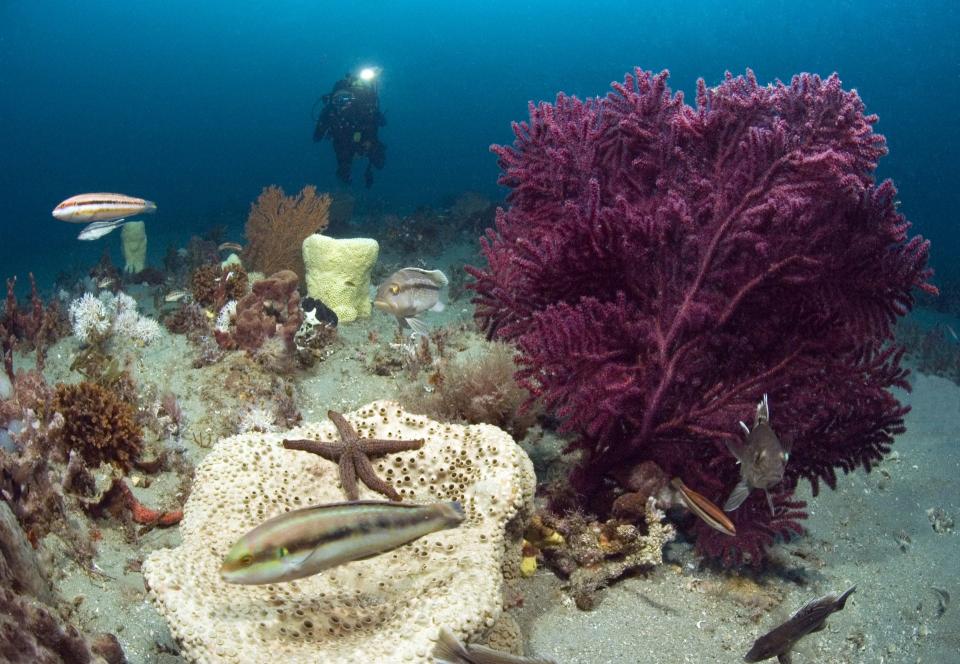New Gray's Reef research vessel aims to capture climate impacts off Georgia coast

In the 41 million square miles of Atlantic Ocean, Gray’s Reef National Marine Sanctuary amounts to a mere speck.
But the 11,000-acre square-shaped preserve, 19 miles off the Georgia coast, is a microcosm of climate change’s outsized influence on oceans and their inhabitants.
On Saturday, the sanctuary christened its newest and largest tool in exploring what is one of the largest near-shore, “live-bottom” reefs off the Southeastern U.S. coast: the 52-foot research vessel Gannet.
“It’s going to be absolutely critical to helping us understand how the resources at Gray's Reef and in the surrounding region are changing (and) how they're adapting to the changing climate,” John Armor, director of the National Oceanic and Atmospheric Agency (NOAA) Office of National Marine Sanctuaries, said in an onboard interview Friday. “And it will help us adapt our management approach, based on the best science.”
Actually, the Gannet ― named for a large but somewhat elusive Atlantic seabird ― felt the impact of climate change before ever reaching its new home at the University of Georgia Skidaway Institute of Oceanography in Savannah.
Low water levels tied to drought disrupted traffic through the Panama Canal, and the cargo vessel carrying the Gannet from its manufacturer in Bellingham, Washington, traveled around South America and through the Strait of Magellan in southern Chile before finally heading north as it finally reached the Atlantic.
“So, it ended up going about 18,000 miles on a ship to get here,” Gray’s Reef Superintendent Stan Rogers said.

Because of its size and features, the Gannet opens opportunities for enhanced research not possible with its predecessor, the Joe Ferguson, which was retired in October after 17 years of service.
“Previous to this boat, we didn’t really have the ability to do much ‘over-the-side' instrumentation work,” Rogers noted. “We have a drop camera and things you could deploy by hand. But we didn't have a crane or a frame with a winch to be able to deploy things like (remotely operated vehicles) or mapping instruments.”
On the Gannet, a 12-foot A-shaped frame can support objects up to 3,500 pounds, while a winch system can reach depths of more than 650 feet, allowing for the deployment of monitoring instruments including underwater robots, ocean gliders and seafloor sensors.
An elevated platform also offers better visibility for monitoring North Atlantic right whales, dolphins and seabirds during survey work.
Gray's Reef also plans to frequently host educators and students for information-rich voyages aboard the Gannet.
"It exposes them to different career paths that they might not have otherwise even known existed," Armor said. "I mean, a career in ocean research – that's a real thing, right? You see actual people doing it, and it's inspiring. Bringing more people into the conversation on ocean conservation is just absolutely critical."
'Salt Bombs': Tybee company makes history with harvest from Georgia's first floating oyster farm
‘That sweet spot on the shelf’
Beyond Gray’s Reef, located directly west of Sapelo Island, the new vessel will allow for enhanced exploration of what remains a largely “unexplored and undiscovered” portion of the Atlantic continental shelf that stretches from North Carolina to central Florida, said Armor.
“We have big ships doing sort of the offshore research and we have small boats doing (near-shore) estuaries,” he added. “But this vessel really is sort of that sweet spot on the shelf.”
With a range of about 460 miles, the Gannet can cover much of that area.
Closer to home, as heat-trapping pollution from the burning of fossil fuels continues to drive temperatures up, the Gannet will allow researchers to better gauge the growing underwater impact of climate change, and to develop sound adaptation strategies to preserve Gray’s Reef, Armor and Rogers agreed.

Not 'right': Speeding vessels off Georgia coast imperiling whales, report finds
But the effects of a warming atmosphere already are evident.
As water temperatures rise, an uptick in extreme weather also has shifted salinity and acidity levels, Rogers said.
“We’re seeing species saying, like, ‘I used to like it here, but now I don’t like it so much, so I want to go this way,’” he added. “So, we’re seeing species shift.”
At the same time, new species, including fish native to the Caribbean, are showing up off the coast of Georgia for the first time.
With temperature readings as high as 90 degrees in sanctuary waters 70 feet deep, that migration should come as no surprise, Rogers said.
“You might as well be in Bermuda,” he added with a laugh.
And it’s not just fish. Gray’s Reef researchers are closely watching new species of algae as they appear in the area for the first time.
“That can be good and can be bad; we don't know yet,” Rogers conceded. “When these new species show up, they can displace others. And especially things like algae, they can come and just dominate habitat and then shade out and outcompete other species.”
Either way, the Gannet will be at the center of efforts to study climate-related changes to the reef.
“A national marine sanctuary without a boat is like a fire station without a firetruck,” said Armor. “We can’t do our job if we can’t get out there.”
John Deem covers climate change and the environment in coastal Georgia. He can be reached at jdeem@gannett.com
This article originally appeared on Savannah Morning News: New Gray's Reef research vessel finds home in Savannah

